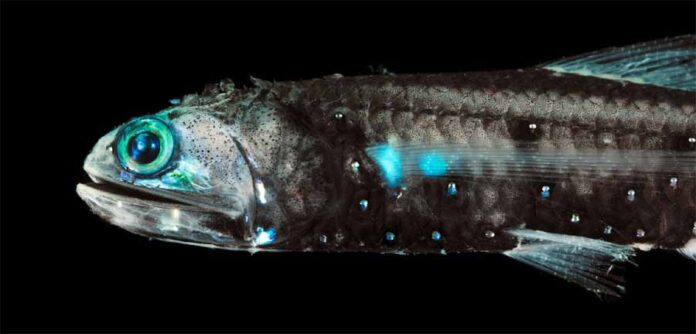by Moira Donovan.
In a dark, unexplored layer of ocean, a hidden cache of fish might play an unexpected role in our climate’s future. It seems like a bad time for a new fishery.
The ocean has a way of upending expectations. Four-story-high rogue waves peak and collapse without warning. Light bends across the surface to conjure chimeric cities that hover at the horizon. And watery wastelands reveal themselves to be anything but. So was the case for the scientists aboard the USS Jasper in the summer of 1942. Bobbing in choppy seas off the coast of San Diego, California, acoustic physicist Carl F. Eyring and his colleagues, who had been tasked with studying a sonar device the navy could use to detect German submarines, were sending sound waves into the deep. But as the echoes of their tests came reverberating back, they revealed a puzzling phenomenon: everywhere the ship went, the sonar detected a mass nearly as solid as the seafloor, lurking about 300 meters or more below the surface. Even more mysterious, this false bottom seemed to shift over the course of the day.
People had their theories—shoals? faulty equipment?—but apart from registering the anomaly, scientists let the mystery slide. (There was, after all, a war on.) It wasn’t until 1945, when oceanographer Martin Johnson dropped nets into the Pacific to take a closer look, that the culprit was definitively unmasked: a vast cloud of marine animals, most smaller than a human hand, that moved from the deep ocean to the surface and back every day.
Since the 1940s, scientists have been unpicking the mysteries of this vertical migration and the creatures taking part in it. Until recently, research focused on zooplankton and other small organisms, neglecting their larger predators. But technological advances have made it possible to look up the food chain in that migrating cloud to examine the variously stealthy, strange, and slimy fish of the mesopelagic zone, the marine “twilight” area between roughly 200 and 1,000 meters deep, where the last rays of surface light penetrate before dissipating into the absolute dark of the sea below. And that research has started to reveal something as significant—and mysterious—as the migration’s first documentation by scientists: by moving carbon through the ocean, migrating fish in the twilight zone, which are thickly distributed enough to have once fooled a sonar, may also play an important role in stabilizing the climate.
Read MOre : First poster of ‘Mother Teresa & Me’ out
Researchers are now attempting to quantify how much carbon the fish in one of the planet’s most unexplored ecosystems are cycling from the ocean’s surface to the deep sea. The inaccessibility of these fish makes this work more challenging than conventional fisheries research, but there’s an urgency nonetheless: the same technological progress that makes it possible to study mesopelagic fish is also making it more enticing to harvest them, even as climate change threatens to reshape the ecosystem.
Mesopelagic fish are not yet commercially exploited, though projects are underway to investigate the marketability of the species and the best methods for harvesting them. Scientists working in this area are, therefore, in the rare position of being able to assess potential impacts from fishing before they happen. But with so many unknowns, the question remains: can they do it in time—for the fishes’ sake and our own?
On a bright day at the ocean’s surface, with rays of light caroming off the water in every direction, it can feel like sunlight is all there is. Some of this light penetrates below the surface into the thin scrim of illuminated ocean known as the euphotic zone, home to all but the deepest algae, phytoplankton, and nearly all commercially fished species. Below this layer, though, sunlight starts to become irrelevant, and things get weird: the water is too murky for photosynthesis, little food is available, and the fish are deeply, resoundingly strange. Take the telescopefish, a ribbonlike being topped with a pearly set of tubular eyes and a bristle-mouthed Cheshire cat grin, or the Sloane’s viperfish, whose jaw can unhinge to trap prey more than 50 percent bigger than itself between its clear, exquisitely pointed teeth.

In 1932, American naturalist William Beebe set out to explore this ecosystem in a vessel known as a bathysphere (a steel ball suspended from a research ship like a pendulum). His initial runs on the excursion were marred by harrowing mishaps, such as a leak around the door at 90 meters and a failure of the communications system. Beebe, who operated with the unquenchable enthusiasm of the truly obsessed, eventually made it to depths of more than 700 meters where he was rewarded with glimpses of fish approximately two meters long, with fangs “illumined either by mucus or by indirect internal lights,” and an anglerfish crowned with three light-tipped tentacles. “No pioneer, peering at a Martian landscape, could ever have a greater thrill than did I,” he later wrote.
Still, what might be most remarkable about mesopelagic fish is not what they are, but what they do.
Every day, many mesopelagic fish species participate in the largest regular migration on the planet. In this process, called diel vertical migration, animals like lanternfish (one of the most abundant kinds of mesopelagic fish) move from the deep water, where they’re protected from predators during the day, to the surface, where they feed overnight—a commute of up to a kilometer for creatures whose iPhone-sized bodies are mostly taken up by light-producing organs and large round eyes.

















